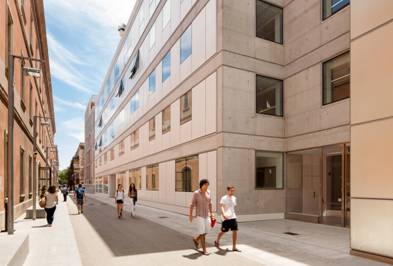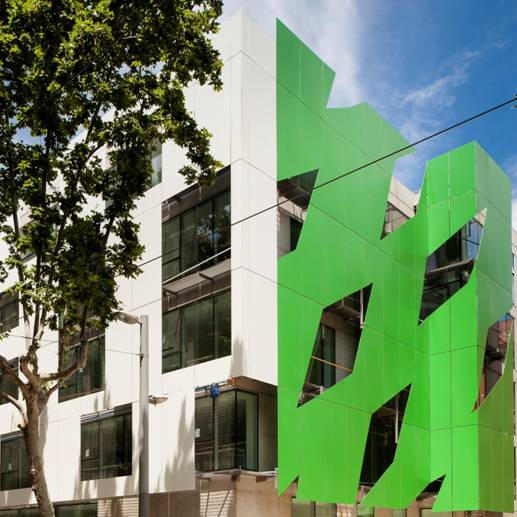Mercè Rodoreda building history
The UPF Research Park
The UPF Research Park was created with a view to occupying a key position on the map of research and knowledge transfer in the social sciences and humanities. It thus brings together various university research groups, internationally acclaimed joint research centres and prestigious institutions in a single setting.
UPF is committed to the creation of this shared physical space, which encourages interactions within this critical mass of knowledge and aspires to become one of Europe's leading research hubs.
The co-existence in one place of groups and centres specialized in a variety disciplines makes it possible to approach important social issues, such as institutional and market design, monetary and fiscal policy, the labour market and unemployment, finance, strategy and rationality, and dependency, equality, education, immigration and health policy, from multiple perspectives. The research lines resulting from these synergies will offer greater insight into social mechanisms and, thus, guidance on both the implementation of public policy and decision-making in the economic and social spheres.
The Park aims to promote excellence in research related to current socio-economic needs. The Park's first building, Mercè Rodoreda 23, was completed in July 2008 and is home to several internationally renowned centres. The second building, inaugurated in November 2014, is interconnected with the first; together, they form a single scientific action unit by enabling regular interaction between the two building's research and knowledge transfer groups.
As in other areas of knowledge, in the social sciences and humanities emphasis is also placed on strengthening the postgraduate programme. It is in the context of the doctoral and postdoctoral programmes in which new ideas are stimulated, cutting-edge research is conducted, presented and discussed, and innovative lines of research are launched. Researchers and doctoral students in the social sciences and humanities need places to work (both individually and in groups), seminar rooms, classrooms and laboratories to conduct, present and discuss the results of their research and share their work with other researchers.
In order to ensure that these activities can be carried out properly, specific spaces have been created, especially designed for these tasks. Thus, classrooms are arranged like amphitheatres, an ideal format for workshops, seminars and special sessions taught by guest lecturers that moreover encourages interaction between postgraduate students and lecturers. Likewise, smaller spaces have been created for discussions in small groups, as have work rooms of various capacities, for the different postgraduate and doctoral groups linked to the UPF centres and research groups at the UPF Research Park. The Park also has a laboratory specialized in economic experiments, the study of individual and group human behaviour, and institutional design.
Description of the building

The campus consists of three research buildings located at the site of the former military barracks on Carrer Wellington: the Mercè Rodoreda 23 and 24 buildings and the Pasqual Maragall Foundation for Research on Alzheimer's Disease (the latter is expected to open its doors in January 2016). The architectural design is by Juan Navarro Baldeweg.
The first building, Mercè Rodoreda 23, which was also the architect's first in Barcelona, spans some 3,550 m2. It is a six-storey building whose floors are connected two at a time by separate sets of ramps. Leisure areas just outside the building enable calm contemplation of the building's exterior. The play of light and shadows caused by a series of innovative sunshades breathes life into the structure, while at the same time protecting against the sun's rays. The third floor is equipped with a glass walkway linking the new structure to the Jaume I building.
The Mercè Rodoreda 23 building is used for new research initiatives - both internal and external - in the social sciences and humanities. The third and fourth floors will eventually house the Research Centre for International Economics (CREI), a research institute jointly sponsored by UPF and the Catalan government; the Centre for Research in Health and Economics (CRES); and the Barcelona Graduate School of Economics (Barcelona GSE).
Mercè Rodoreda 24 is a research building spanning a total of 8,685 m2 that was specifically designed to enable the implementation and consolidation of the UPF Research Park in the social sciences and humanities. It consists of a basement level, a ground floor and five additional storeys, each of which is connected to the equivalent storey of the first building, allowing them to form a single functional unit. Among other areas, it features: a multi-purpose hall, meeting rooms, rooms for group work, seminar rooms, offices for individual researchers and research centres, and spaces to interact and socialize.
This building is home to the following research groups, centres and institutions:
- Complexity and Socio-Ecological Dynamics Research Group (CaSEs)
- Health Inequalities Research Group - Employment Conditions Network (GREDS-EMCONET)
- Interdisciplinary Research Group on Immigration (GRITIM)
- Behavioural and Experimental Sciences Laboratory (BES_Lab)
- Research and Expertise Centre for Survey Methodology (RECSM)
- Sociodemographics Research Group (DEMOSOC)
- Johns Hopkins University-Universitat Pompeu Fabra Public Policy Center (JHU-UPF PPC)
- Barcelona School of Economics (BSE)
- Barcelona Institute for International Studies (IBEI)
- Institute of Political Economy and Governance (IPEG)
- UPF Barcelona School of Management
- UPF-IDEC
Architectural description of the Mercè Rodoreda 24 building by Juan Navarro Baldeweg

This project follows the urban planning guidelines laid out in the original submission for the call for proposals for the entire block in 1996. The proposal, which ultimately won the tender, consisted of three interconnected modules that would create a very slight opening near Ciutadella Park by setting the central building back and angling the planes of the façades of the buildings that flank it.
This building, which opened its doors in November 2014, is both the central module and the largest. It is separated from the other two by narrow courtyards that open onto Carrer Wellington and are bedecked with colourful sunshades intended to encourage a dialogue between the buildings and visually enliven the connecting areas, while at the same time helping to filter the sun.
The park's first building, inaugurated in 2008, can be found to the west of the central module. The building to the east, still under construction, will eventually house the Pasqual Maragall Foundation for Research on Alzheimer's Disease. The block will thus consists of a total of three buildings dedicated to research that will constitute an integrated set of modules, each with its own distinct image, yet formally conceived to complement the others. The westernmost module is a box of shiny, silver glass, one side of which is protected by red sunshades. In contrast, the module to the east, arranged around the perimeter, conveys a strong sense of volume and features façades made of both transparent and silver glass.
Construction on the central module began in 2011. The side of the building overlooking Ciutadella Park has a double-layered façade. The outer layer, made of white lacquered aluminium, is punctuated by large rectangular openings that both make it possible to look out from inside and protect against and soften the strong sunlight. These elements are free of the usual details, which have been reserved for the windows they hide. This mask wraps the building in a uniformly luminous shell that plays up the red and green filtering elements of the open courtyards that run between the modules. The enclosure wall facing the interior street bordering the building is more conventional, with a façade studded by large windows oriented so as not to require special protection from the sun and modular composite aluminium elements, also lacquered in white.
The building's functional areas are spread out over six above-ground floors and a basement level. Individual offices for researchers and classrooms are located on the above-ground floors. A shared westward-facing lobby area is presided over by an open stairway connecting all the floors. Due to the transparency of the surrounding façade, the red sunshades of the module to the west are visually incorporated into the building. This open vertical lobby includes shared leisure areas, thus offering a large space to bring the various activities conducted at the centre together.
One area of particular value is the conference hall and large meeting room, which can accommodate 160 people when used as an amphitheatre and about 50 when set up for meetings. Care has been taken to ensure that the entire building receives natural light, including this conference hall and meeting room, which is located in the basement. The rest of the basement level consists of shared activity spaces, such as seminar rooms and multi-purpose classrooms, all well-lit as a result of the light shafts that run vertically down the structure to ground level.
The building has a visually attractive and formally varied image both when viewed from the side from Carrer Wellington and when seen from a distance from Ciutadella Park.
